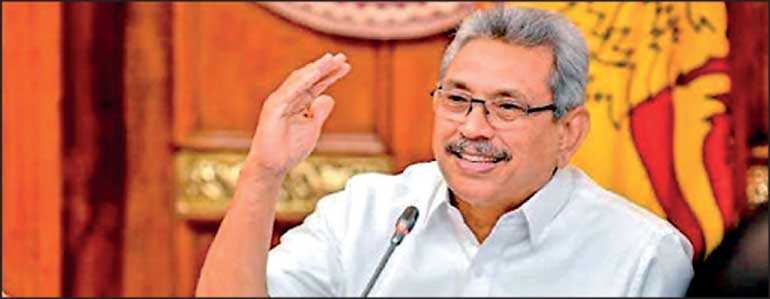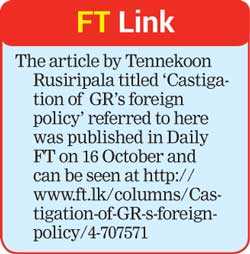Monday Feb 24, 2025
Monday Feb 24, 2025
Saturday, 17 October 2020 00:04 - - {{hitsCtrl.values.hits}}

Since Sri Lanka is neither an absolute monarchy nor a dictatorship – as yet – by what policy process, involving whom, and when, did President Gotabaya Rajapaksa decide on replacing nonalignment with neutrality, redefining Sri Lanka as a neutral, not nonaligned country, and dropping any reference to our membership of the Nonaligned Movement, a huge community of similar and like-minded states, mostly of the global South? Did Prime Minister Mahinda Rajapaksa, Foreign Minister Dinesh Gunawardena, the Cabinet, and the Government Parliamentary group join in the policy deliberation and was there a policy consensus?
By Dr. Dayan Jayatilleka
1.President Gotabaya Rajapaksa, addressing the UN General Assembly’s 75th anniversary summit, omitted any reference to Nonalignment or the Nonaligned Movement. That was the first time that any Ceylonese/Sri Lankan leader had omitted such a marker reference since this country was a founder-member of the Nonaligned Movement in Belgrade in 1961. Why did the President omit such a defining reference?

2.The President used instead the term ‘neutral’. He did not say ‘neutral and Nonaligned’ as does Foreign Minister Dinesh Gunawardena, which itself is a departure from the norm, and in any case would read better as ‘Nonaligned and neutral’, but is far better than the sole use of the term neutral/neutrality instead of Nonaligned/Nonalignment.
3.While S.W.R.D. Bandaranaike did use the term ‘dynamic neutrality’, that was years before the founding of the Nonaligned movement in 1961, at which Madam Sirimavo Bandaranaike represented Ceylon. The NAM (and Sri Lanka) never used the term ‘neutral/neutrality’. Firmly rooted in the NAM and the doctrine of Nonalignment, Madam Bandaranaike was famously able to balance between India and China. Balance and equidistance need equal friendship with both players; not the abandonment of Nonalignment and declaration of a conversion to ‘neutrality’ –while in practice, permitting one’s State Minister to speak in hostile terms in parliament about the Prime Minister of your neighbor while a dignitary of the other country is visiting.
 4.The Secretary to the Foreign Ministry, Rear-Admiral (retd) Dr. Colombage, made clear in an uncontradicted, on-the-record interview, that the President’s vision is of Sri Lanka as a neutral, not a Nonaligned country. This explains why, in his UNGA address, the President used the term neutral rather than Nonaligned, and chose not to use the inclusive terminology of Nonaligned and neutral. It denotes a change-over, a switch, a conversion.
4.The Secretary to the Foreign Ministry, Rear-Admiral (retd) Dr. Colombage, made clear in an uncontradicted, on-the-record interview, that the President’s vision is of Sri Lanka as a neutral, not a Nonaligned country. This explains why, in his UNGA address, the President used the term neutral rather than Nonaligned, and chose not to use the inclusive terminology of Nonaligned and neutral. It denotes a change-over, a switch, a conversion.
5.It is a switch that in no way serves the national interest of Sri Lanka as a state; a country. The Nonaligned Movement may be likened to an extended family or a trade union. As in the case of families and trade-unions, there are fluctuations in its fortunes. However, at the last summit of the Movement in Baku, Azerbaijan in 2019 – the same year that President Gotabaya Rajapaksa was elected – the NAM had 120 member states, making it the largest grouping in the UN and the international system as a whole. It is this global coalition and our membership of it, and role and status in it, that gives us the chance of a bloc-vote in UN bodies. How can it be in the interest of Sri Lanka, a small state, to drop any identification with, and role in, such a large coalition of which it was a founder-member and a chairperson?
6.Only a handful of countries, barely making it into a double-digit total, identify themselves as ‘neutral’. Neutrality is also generally understood as relevant in the context of a shooting war or its imminence. How can it be a rational choice to drop the identification with a category that 120 countries subscribe to and opt instead for a category that barely a dozen countries do?
7.How can the fact that Mervyn de Silva identified and criticised the deviation from Nonalignment in the 1980s soon after Sri Lanka handed over its Chairmanship of NAM, contradict my assertion that the same mistake has been made yet again? Sri Lanka’s departure from its foreign policy norms in the 1980s was an aberration which was corrected by the trauma of 1987, and it returned to its home turf thereafter under Presidents Premadasa, Kumaratunga and Rajapaksa, with even President Sirisena fighting against a repetition of the deviation under Prime Minister Wickremesinghe. During the Sirisena administration, under the Foreign Ministerships of Tilak Marapona and Sarath Amunugama, we had returned to centrist Nonaligned position after a drastic initial deviation which accounted for the co-sponsorship of the disgraceful Geneva 2015 resolution.
8.It is precisely when Sri Lanka deviated from Nonalignment in the 1980s that we experienced international intervention and found ourselves isolated. President Mahinda Rajapaksa’s commitment to Nonalignment kept Sri Lanka safe in the war years, from possible interference and intervention. Postwar, we lost the vote three times in the UNHRC Geneva because he delayed, under hawkish pressure, the implementation of his promise to India regarding the 13th Amendment and thereby lost the unstinted support of India, which as Mervyn de Silva pointed out in the 1980s, was the cornerstone of our Nonalignment. What is the logic of President GR repeating an error of President JR in the 1980s – of deviating from Nonalignment – an error which made us vulnerable and isolated – while completely abandoning Nonalignment and renouncing our Nonaligned collective identity and sense of belonging which kept us safe from interference/intervention in wartime?
9.Since Sri Lanka is neither an absolute monarchy nor a dictatorship – as yet – by what policy process, involving whom, and when, did President Gotabaya Rajapaksa decide on replacing nonalignment with neutrality, redefining Sri Lanka as a neutral, not nonaligned country, and dropping any reference to our membership of the Nonaligned Movement, a huge community of similar and like-minded states, mostly of the global South? Did Prime Minister Mahinda Rajapaksa, Foreign Minister Dinesh Gunawardena, the Cabinet, and the Government Parliamentary group join in the policy deliberation and was there a policy consensus?
10.The non-mention of Palestine by President Gotabaya Rajapaksa, for the first time by any Sri Lankan leader in a UNGA address after the founding of the NAM, is no mere slip. Palestine is the longest standing issue on the NAM agenda and the most glaring moral and ethical issue in world politics today. President Gotabaya’s deafening silence is not only in stark contrast to the commitment to the Palestinian cause and the two-state solution of his predecessor President Mahinda Rajapaksa over decades, but will also not go unnoticed by the Organization of the Islamic Conference (OIC) and the Nonaligned group in UN forums, which constitute important voting blocs for Sri Lanka.
Discover Kapruka, the leading online shopping platform in Sri Lanka, where you can conveniently send Gifts and Flowers to your loved ones for any event including Valentine ’s Day. Explore a wide range of popular Shopping Categories on Kapruka, including Toys, Groceries, Electronics, Birthday Cakes, Fruits, Chocolates, Flower Bouquets, Clothing, Watches, Lingerie, Gift Sets and Jewellery. Also if you’re interested in selling with Kapruka, Partner Central by Kapruka is the best solution to start with. Moreover, through Kapruka Global Shop, you can also enjoy the convenience of purchasing products from renowned platforms like Amazon and eBay and have them delivered to Sri Lanka.
Discover Kapruka, the leading online shopping platform in Sri Lanka, where you can conveniently send Gifts and Flowers to your loved ones for any event including Valentine ’s Day. Explore a wide range of popular Shopping Categories on Kapruka, including Toys, Groceries, Electronics, Birthday Cakes, Fruits, Chocolates, Flower Bouquets, Clothing, Watches, Lingerie, Gift Sets and Jewellery. Also if you’re interested in selling with Kapruka, Partner Central by Kapruka is the best solution to start with. Moreover, through Kapruka Global Shop, you can also enjoy the convenience of purchasing products from renowned platforms like Amazon and eBay and have them delivered to Sri Lanka.